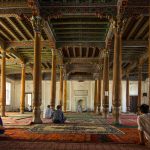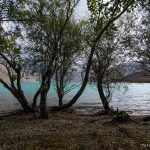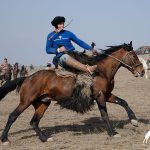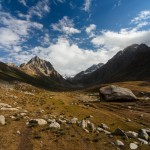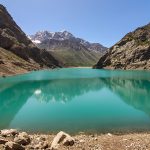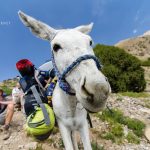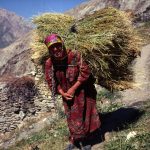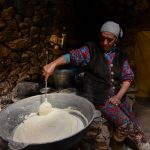The Fergana Valley, sometimes spelled ‘Farghana’ or ‘Ferghana’, is a three-sided valley that connects Northern Tajikistan to the southerly end of Kyrgyzstan and the easterly section of Uzbekistan in Central Asia. Totally off the beaten track, this ancient region is characterized by age-old mosques, fascinating madrassas, friendly people, and bustling bazaars showcasing a plethora of traditional crafts from handspun pottery to the finest silk.
Dating back over two thousand years, the Fergana region has been the site of major conflict with its neighbors fighting over the region’s natural resources, including cotton, natural rock, and a small quantity of oil. With humble beginnings as a trading route for the Persians and the Greeks, the Fergana Valley has passed hands throughout the years – from Babur’s Mughal Dynasty and Soviet Russia in the late 19th-century, to finally forming three independent republics in the early 1990s – northern Tajikistan being the main one.
Tucked between two mountain ranges, the Tengri Tagh and the Gissar-Alai, the Fergana Valley covers an impressive 8,500 square miles of cattle-grazing farmland, snow-capped mountains, traditional villages, and fertile valleys. In fact, as it is fed by two rivers which flow onwards into the Syr Darya River, Fergana is one of Central Asia’s most fertile valleys – delicious fruit, vegetables, and other agricultural products thrive here.
Today, the Fergana Valley remains a popular trading route along the famous Great Silk Road. Cotton, grain, leatherwork, coal mining, and (historically) stock breeding of Fergana Valley horses have been the region’s most prominent industries. But it is not just the scenery and natural resources that make this untapped section of the globe such a treat to visit. The Fergana Valley and indeed the north of Tajikistan as a whole boast hot summers and moderately cold winters with very little rainfall for a large part of the year that makes for excellent year-round hiking and trekking adventures.
While it may not be everybody’s cup of tea, a visit to the Fergana Valley’s northern Tajikistan region is a major highlight for the most ambitious of travelers. After all, it’s not your average fly and flop holiday. Instead, there is plenty of history and culture to uncover if you are committed to the search. And if you are looking for things to do in the Fergana Valley, there are some fascinating highlights waiting for you.
Several main villages and towns are worth adding to your Fergana Valley tour. Khujand, one of the oldest cities in Central Asia, and Istaravshanand, home to a captivating old citadel, both make a great base for your northern Tajikistan holiday with excellent accommodation options and transport links for getting around.
Discover the fascinating history of Khujand (now known as Sughd) with its Islamic mosques and mausoleums, historic citadels, authentic museums, scenic parks, and lively bazaars.
The bustling Panjshanbe Bozor is the oldest market in Tajikistan, and a must-see attraction while you are in Khujand where you can shop for locally grown produce amongst locals. The Arbob Cultural Palace, also known as ‘the Palace of the People’ is another Khujand highlight – an impressive building that was once used by the Soviets.
Istaravshan, tucked away on the northern slopes of the Turkistan mountains, is another worthy stop on your north of Tajikistan bucket list. Set in the middle of two main Tajik cities, Khujand and Dushanbe, it is easily fit into a northern Tajikistan tour. Dating back to the 6th-century, this ancient city was once known for its handicrafts like pottery. Today, it is a flourishing fruit and wine-growing capital. Top Istaravshan attractions include the 16th-century blue-domed Kok-Gumbez Mosque, the winding streets of the Shahr-e-kuhna old town, the Sary Mazar mosque and tombs, and the ruins of the Mug Teppe fortress.
Straddling the border between Tajikistan and Kyrgyzstan, Isfara is one of the most ancient old towns in Central Asia. Dating back to the 10th-century when it was a hotspot on the Great Silk Road, it boasts a range of historic monuments, traditional teahouses, and apricot orchards. Visit the wooden 8th-century Hazrati Shoh Mausoleum, the Apricot Monument, the 16th-century Abdullo Khan Mosque, Isfara Museum, Isfara Bazaar, and the famous Lenin Statue.
Running between Khujand and Istaravshan, and alongside the Fann River at some points, the Shahriston pass is one of the most captivating drives in the world. While there are not that many things to do in Shahriston itself, there are several historical sites dating back to the early Middle Ages nearby. Explore the ancient ruins of Bunjikat, once home to the three-tiered Kalai Kahkaha fortress, the castles of Chilhujra, and the ruined temples and towers of ancient Panjakent.
But the Fergana Valley attractions do not end there. Tick Tabashar, now known as Istiklol, off the list with its historic wartime sites. Much lesser-known than any of Tajikistan’s other towns, Tabashar’s claims to fame are its Soviet-era Tajik uranium mine, local bazaar, and a series of stone houses built by German POWs during the Second World War.
History buffs may also enjoy hunting down the many statues dedicated to Vladimir Lenin in northern Tajikistan, the communist leader of the Russian Revolution. The biggest Lenin statue can be found in Khujand, while another can be found in Istaravshan. Several smaller Lenin statues are scattered throughout Tajikistan, in Isfara, Istiklol, Murghab, Panjakent, and Khorog.
From trekking trips and crafts to Lenin statues and ancient ruins, there is so much to see on a Fergana Valley adventure. If you are looking for other things to do in northern Tajikistan, take a look at our suggested Fergana Valley and North of Tajikistan itineraries.






